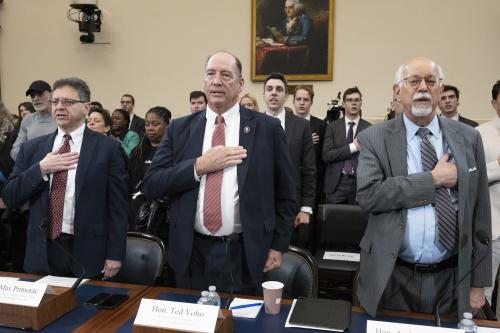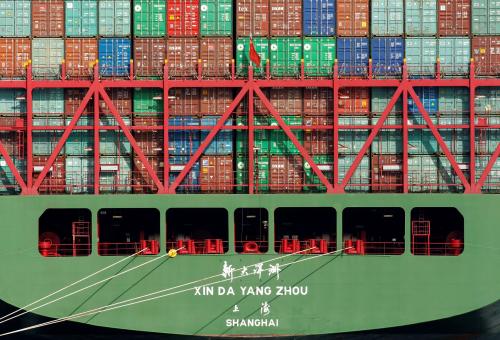The highly anticipated, week-long state visit by Japan’s Prime Minister Shinzo Abe to the United States and his April 28 meeting with President Obama were, overall, a success. Abe became the first Japanese prime minister to address a joint meeting of Congress and together with President Obama, he announced a joint vision statement for the two allies. Prior to the prime minister’s arrival in Washington, Brookings Senior Fellow Mireya Solís identified three major priorities for the visit: security, trade, and historical reconciliation. These issues were advanced to varying degrees.
The most tangible results were achieved in security. New bilateral defense cooperation guidelines were announced on the eve of the Obama-Abe meeting, a much needed update from the previous 1997 guidelines. At a Brookings event on May 4, Brookings Senior Fellow Jeffrey Bader noted that the guidelines represent incremental—not abrupt—change in the alliance, and clarify roles for the United States and Japan. They provide an outline for the legislation that Abe will seek from the Japanese Diet later this year. Senior Japanese politicians who spoke at Brookings were cautious in their assessments of the defense cooperation guidelines. Koichiro Gemba, of the opposition Democratic Party of Japan (DPJ), expressed concern that the announcement of the guidelines may lead to misunderstandings between the United States and Japan regarding Japan’s ability to conduct collective self-defense, since full legislation on the revised guidelines has yet to be discussed in the Diet and explained to the public. Isamu Ueda from Komeito, the ruling party’s coalition partner, acknowledged that the government would need to carefully and clearly explain the legislation to the public in advance of the Diet deliberation. Debate on draft legislation is tentatively scheduled to begin in the Diet in mid-May.
In the Obama-Abe meeting, trade was perhaps the area in which there were the highest hopes and expectations, but which achieved the fewest results. Both administrations had earlier hoped to announce the conclusion of bilateral negotiations on the Trans-Pacific Partnership Agreement (TPP), which would have been a huge confidence booster for both sides and would have gone a long way in reassuring the other TPP members. However, these expectations were tempered as the visit drew closer. Although both President Obama and Prime Minister Abe reaffirmed their commitment to the TPP negotiations, they were not able to make any groundbreaking announcements on progress in the bilateral negotiations. Before Abe’s arrival, Mireya Solís said that without this type of announcement “the summit can at best be only a partial success,” a sentiment that she echoed in a media interview following the summit, stating that the meeting was “a missed opportunity,” since it did not force a conclusion to the bilateral negotiations.
The increasing importance of TPP was emphasized by both Japanese and American speakers at Brookings. Yasutoshi Nishimura, state minister for the Cabinet office, said that TPP is a “main pillar of [Japan’s] growth strategy” and Solís added that it is a litmus test for Japan’s ability to successfully undertake structural reform. For the United States, the TPP is an integral part of the Obama administration’s Asia rebalance strategy. And while none of the panelists stated that the lack of trade promotion authority (TPA) was holding Japan back in the bilateral negotiations, the strong belief that TPA is essential to the success of TPP negotiations is shared by many.
Historical reconciliation was the most controversial topic during the trip. Although the substance of the trip was mainly U.S.-Japan relations, there had been speculation whether Abe would use this opportunity to address some of Japan’s historical issues with South Korea and China. In his address to Congress, Abe offered his condolences for the American lives lost during World War II and referenced the suffering caused by Japanese actions in Asia, saying that he would “uphold the views expressed by the previous prime ministers.” Jeffrey Bader noted that this acceptance of the Kono Statement on “comfort women” and endorsement of the statements made by previous prime ministers was sufficient for an American audience. But many Korean and Chinese observers were underwhelmed by the address, and Prime Minister Abe will be under even more intense scrutiny from these neighbors as he prepares for his August 15 speech commemorating the 70th anniversary of the end of World War II.
While Abe’s visit was successful to varying degrees, it left no doubt about the continued strength of the U.S.-Japan alliance and the shared interests and goals of the two countries. However, in each of the areas touched upon during Abe’s visit there will be challenges in the near future: The Japanese Diet will deliberate on potentially unpopular legislation regarding the new defense cooperation guidelines, the U.S. Congress will debate the passage of trade promotion authority while the U.S.-Japan bilateral TPP negotiations try to finally reach an agreement, and there will be heightened pressure surrounding Abe’s August 15 speech. In recent years, the United States and Japan have striven to establish a more multidimensional, global alliance. How they meet and work to overcome these challenges will define the type of alliance we can expect to see in the future.
The Brookings Institution is committed to quality, independence, and impact.
We are supported by a diverse array of funders. In line with our values and policies, each Brookings publication represents the sole views of its author(s).


Commentary
Measuring the success of Abe’s U.S. visit
May 11, 2015